Weekly Reports from Jordan
Choose Year: or Choose week
July 19-23, 2010
What to watch for in this week’s report:
• John McDowell, excavation photographer from Pacific Union College, writes about the end time.
• Kent Bramlett, chief archaeologist from La Sierra University, provides an update on the archaeological finds of the week.
• Douglas Clark, excavation director from La Sierra University, reflects on culture and hospitality in our part of Jordan.
• Douglas Clark and John McDowell have collected quips, quotable quotes and photogenic photos from this past week’s experiences in Jordan
Notes Towards the End of Time

 Thursday this week intimations of fog rolled over the tell. Some even shivered a little as in the fog the ghostly figure of David moved toward his square.
Thursday this week intimations of fog rolled over the tell. Some even shivered a little as in the fog the ghostly figure of David moved toward his square.
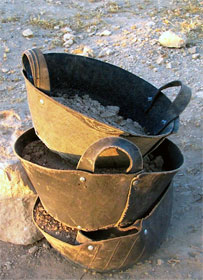 This week we started thinking seriously about the End of Time—the wrapping up of the season. Next Monday and Tuesday the fields will close, the last guffa will be sifted, rocks brushed one last time, final photos taken, and the last pottery sherd will be washed, and we put it all away for next season.
This week we started thinking seriously about the End of Time—the wrapping up of the season. Next Monday and Tuesday the fields will close, the last guffa will be sifted, rocks brushed one last time, final photos taken, and the last pottery sherd will be washed, and we put it all away for next season. 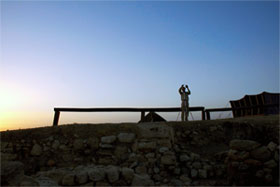 We
We 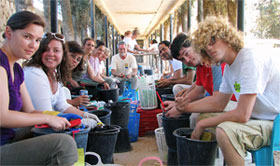 will leave wondering what did we just miss that will be found next season? Will architecture emerge in the top part of Field L? Each season answers questions—there is now a nice sequence of three more houses running south from the partially reconstructed Four-Room House. We know a little more about domestic life around 1200 B.C.
will leave wondering what did we just miss that will be found next season? Will architecture emerge in the top part of Field L? Each season answers questions—there is now a nice sequence of three more houses running south from the partially reconstructed Four-Room House. We know a little more about domestic life around 1200 B.C. 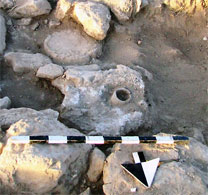 The olive press that David and
The olive press that David and 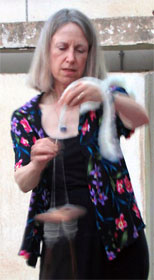 Mary have been looking for, for some years, was found. We will remember how Mary Boyd tried to teach us how to spin wool, and how Nikki taught us how to make flint tools.
Mary have been looking for, for some years, was found. We will remember how Mary Boyd tried to teach us how to spin wool, and how Nikki taught us how to make flint tools. 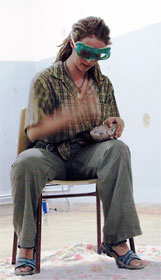 All fields present new puzzles. For example, some of the architecture in Field H still presents questions. What were the ancients thinking? Surely, they could have been much more considerate towards future archaeologists!
All fields present new puzzles. For example, some of the architecture in Field H still presents questions. What were the ancients thinking? Surely, they could have been much more considerate towards future archaeologists!
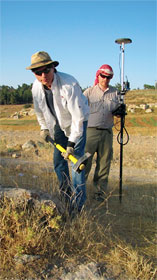 Even as one closes down a season, there are things to think about for next season and beyond. One of the projects this season was to mark out the perimeter of what we wish to preserve of the tell for the future from encroaching housing developments. Securing the land involves delicate ongoing negotiations between the two site owners, the Department of Antiquities, and issues of cost. Specifically for next season, there were discussions with representatives from the Palestinian Refugee Camp who run an Orphan’s retreat at the school.
Even as one closes down a season, there are things to think about for next season and beyond. One of the projects this season was to mark out the perimeter of what we wish to preserve of the tell for the future from encroaching housing developments. Securing the land involves delicate ongoing negotiations between the two site owners, the Department of Antiquities, and issues of cost. Specifically for next season, there were discussions with representatives from the Palestinian Refugee Camp who run an Orphan’s retreat at the school.  When we come, and when 400 boisterous, excited children come will have to be carefully negotiated with Ramadan in mind, which will fall during the next dig season.
When we come, and when 400 boisterous, excited children come will have to be carefully negotiated with Ramadan in mind, which will fall during the next dig season.
 Other memories include the fact that Kent (Gazelle Legged) Bramlett had a penchant for flat tires. He racked up four this season.
Other memories include the fact that Kent (Gazelle Legged) Bramlett had a penchant for flat tires. He racked up four this season.  Doug Clark’s penchant was making announcements (a required side-dish with each lunch), and a love of ice-cream—the ice-cream tending to receive more applause and appreciation than the announcements—a conundrum that Doug has also not yet solved.
Doug Clark’s penchant was making announcements (a required side-dish with each lunch), and a love of ice-cream—the ice-cream tending to receive more applause and appreciation than the announcements—a conundrum that Doug has also not yet solved. 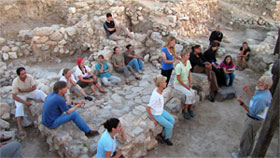 Returning from the Tuesday evening lecture out at the Four-Room House after a particularly long day of pottery washing (15 buckets from Field L alone),
Returning from the Tuesday evening lecture out at the Four-Room House after a particularly long day of pottery washing (15 buckets from Field L alone),  Doug rewarded the dedicated work ethic of the team with ice-cream at the Mövenpick—among the best tasting found anywhere!.
Doug rewarded the dedicated work ethic of the team with ice-cream at the Mövenpick—among the best tasting found anywhere!.
 There is no question that the smaller team this year has been particularly dedicated and hardworking. The Director General of the Department of Antiquities, Dr. Ziad Al-Sa`ad, during his recent visit to the tell commented on the professionalism of the work being done at the site—high praise indeed!
There is no question that the smaller team this year has been particularly dedicated and hardworking. The Director General of the Department of Antiquities, Dr. Ziad Al-Sa`ad, during his recent visit to the tell commented on the professionalism of the work being done at the site—high praise indeed! 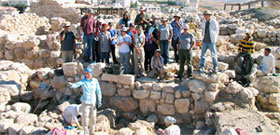 The site has, in fact, attracted a range of visitors—from students studying Arabic, students from other digs to the Friends of Archaeology of Jordan. Such visits underscore the growing recognition of the significance of Tall al ‘Umayri and the work being done here.
The site has, in fact, attracted a range of visitors—from students studying Arabic, students from other digs to the Friends of Archaeology of Jordan. Such visits underscore the growing recognition of the significance of Tall al ‘Umayri and the work being done here.
 Saturday evening the bus and cars headed to the Seven Hills Restaurant situated above the tell for the end of season traditional Bedouin feast—a Mansaf. This meal involves cultivating the skill of rolling a mixture of rice, yogurt (actually lebna—a very thick yogurt), lamb, and spices into ball with your right hand (the left hand is not used for eating in Bedouin culture) and then placing the ball into your mouth without your fingers touching your lips. It’s a skill that requires a fair amount of practice!
Saturday evening the bus and cars headed to the Seven Hills Restaurant situated above the tell for the end of season traditional Bedouin feast—a Mansaf. This meal involves cultivating the skill of rolling a mixture of rice, yogurt (actually lebna—a very thick yogurt), lamb, and spices into ball with your right hand (the left hand is not used for eating in Bedouin culture) and then placing the ball into your mouth without your fingers touching your lips. It’s a skill that requires a fair amount of practice!
 After a photo op with the Mudira (the women field supervisors), newly (and temporarily) tattooed, and speeches of thanks by Doug and Kent to a number of individuals who have made our activities possible, including many from the community as well as members of the team, Matt Vincent gave out the newly dubbed “Guffa” awards (plural, Guffaf, from which Goof-off is likely the best rendition). The award for:
After a photo op with the Mudira (the women field supervisors), newly (and temporarily) tattooed, and speeches of thanks by Doug and Kent to a number of individuals who have made our activities possible, including many from the community as well as members of the team, Matt Vincent gave out the newly dubbed “Guffa” awards (plural, Guffaf, from which Goof-off is likely the best rendition). The award for:
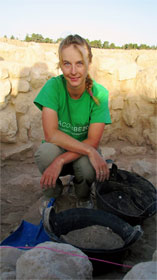 “Boundless Optimist” went to Anita
“Boundless Optimist” went to Anita
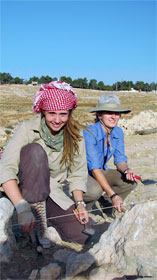 “Most Pottery Collected” went to Nikki and Olivia
“Most Pottery Collected” went to Nikki and Olivia
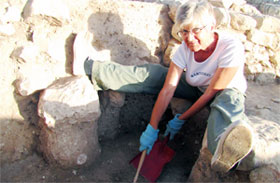 “Most Flexible Archaeologist” went to Vera
“Most Flexible Archaeologist” went to Vera
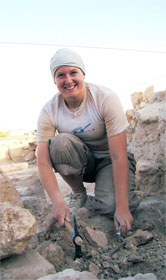 “Most Squares Excavated and Recorded (6)” went to Jillian
“Most Squares Excavated and Recorded (6)” went to Jillian
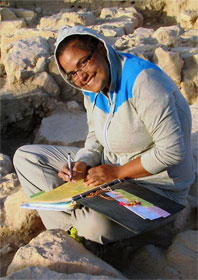 “Best Candy Packing Rambo” went to Rainbow
“Best Candy Packing Rambo” went to Rainbow
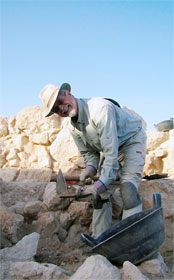 “Most Meticulous Excavator” went to Gary
“Most Meticulous Excavator” went to Gary
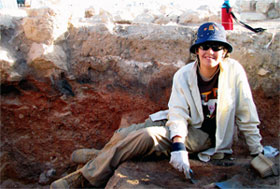 “Archaeologist Most Likely to Save the World in the Event of a Zombie Attack” went to Aran
“Archaeologist Most Likely to Save the World in the Event of a Zombie Attack” went to Aran
And (drum roll)
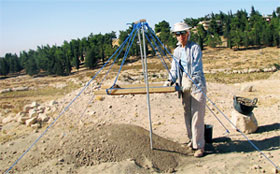
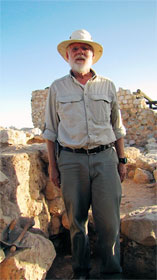 “Most Guffas Sifted in One Day” went to Mary and Doug, whose combined total of 252 was stellar
“Most Guffas Sifted in One Day” went to Mary and Doug, whose combined total of 252 was stellar
And (second drum roll)
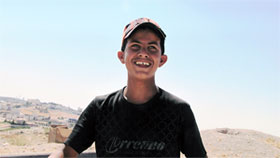 “Day-long Break Specialist” went to Matt Vincent, supported by Justin Waring-Crane’s earlier documented “overheard” comment: “So what’s it like having a day-long break?
“Day-long Break Specialist” went to Matt Vincent, supported by Justin Waring-Crane’s earlier documented “overheard” comment: “So what’s it like having a day-long break?
This coming week we do our final digging and then we close it down. The End of Time is nigh. We are getting ready to go—a few have left already. Once all the tell dirt has been washed from our clothes, and we reflect back on the season and all that we did together, we will also certainly remember the smiles of welcome from the people of Jordan.
Week Five Excavation Report and Finds
As the “end of time” is approaching, we are calibrating all that we do in the field with the realization that the end of our stay here is nearly upon us. However, there is a sense of accomplishment along with the urgency to reach good stopping places.
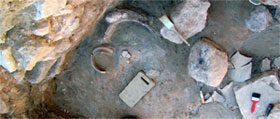 Field A has finally reached floors in all of its excavation areas. This is really a pleasing accomplishment. Ken Crane and company, with the addition of some help from his field compatriots who finished excavating the room with the hearth next door, have reached the surface and discovered an assemblage of pottery that was smashed when the roof burned and caved in. They have uncovered parts of several crushed large storage jars, a jug, and a flask painted with concentric rings in a style typical of the late 13th-12th centuries BC. The floor of this room is lower than the surfaces revealed in the house next door, and probably represents a fourth house along the western perimeter wall of the early Iron I village. But the extra depth of burned mud-brick they had to dig through to reach the floor also ensured that objects and pottery were safely preserved from disturbance over the ensuing millennia. In reaching the floor, we also learned that the large saddle quern found last week was not sitting on the floor, but had fallen from the second story and was resting on ceiling debris (from the second story floor) about 15 cm deep.
Field A has finally reached floors in all of its excavation areas. This is really a pleasing accomplishment. Ken Crane and company, with the addition of some help from his field compatriots who finished excavating the room with the hearth next door, have reached the surface and discovered an assemblage of pottery that was smashed when the roof burned and caved in. They have uncovered parts of several crushed large storage jars, a jug, and a flask painted with concentric rings in a style typical of the late 13th-12th centuries BC. The floor of this room is lower than the surfaces revealed in the house next door, and probably represents a fourth house along the western perimeter wall of the early Iron I village. But the extra depth of burned mud-brick they had to dig through to reach the floor also ensured that objects and pottery were safely preserved from disturbance over the ensuing millennia. In reaching the floor, we also learned that the large saddle quern found last week was not sitting on the floor, but had fallen from the second story and was resting on ceiling debris (from the second story floor) about 15 cm deep.
Field H has been working hard to trace surfaces across the central rooms of the pillared building and excavate down to define several small rooms that flank the north side of the structure. The overall plan of the building appears to impose the template of a typical Iron I pillared or four-room house within the walls of a larger building. But there were additional spaces to make use of, and the architects partitioned a northern extension into at least four small rooms. This area will not get fully excavated this season, but Hew, Carolyn, and Kambiz have been working hard to reach a point that clarifies the wall lines. 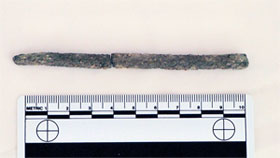 While excavating some of the debris, Hew found a bronze shaft about the thickness of a pencil which may have been part of a weapon point. The outer two of the three long rooms in the center of the building are paved with stones. The compacted earth floor of the center room has been hard to trace, but patches of plaster and flat-lying pottery sherds indicate where it once was, though damaged by the impact of fallen wall stones and perhaps poorly maintained during the later life of the building. Excavation of a broad room to the south of these rooms will have to wait until next season, as well as completing connections to another room against the perimeter wall to the west.
While excavating some of the debris, Hew found a bronze shaft about the thickness of a pencil which may have been part of a weapon point. The outer two of the three long rooms in the center of the building are paved with stones. The compacted earth floor of the center room has been hard to trace, but patches of plaster and flat-lying pottery sherds indicate where it once was, though damaged by the impact of fallen wall stones and perhaps poorly maintained during the later life of the building. Excavation of a broad room to the south of these rooms will have to wait until next season, as well as completing connections to another room against the perimeter wall to the west.
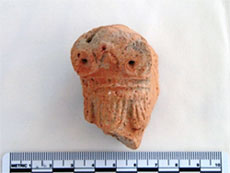 In Field L excavation around the oil press installation revealed a large broken jar that adds to our understanding of the complexity of the installation.
In Field L excavation around the oil press installation revealed a large broken jar that adds to our understanding of the complexity of the installation.  Unfortunately, the collecting surface was not sufficiently well preserved for the archaeologists to reconstruct a full understanding of the layout, but enough elements were present to identify the activity of the ancient inhabitants in this part of the building. In another part of Field L, John McDowell found the fragment of a ceramic object that might be seen as a horse head, or if turned another way, architectural features from a model building. John’s preferred interpretation is the horse head, impeccably argued from the fact that he was born in the year of the horse! Also from Field L this week, Olivia and Nikki each found joining parts that look like the lower torso and legs of an anthropomorphic figurine.
Unfortunately, the collecting surface was not sufficiently well preserved for the archaeologists to reconstruct a full understanding of the layout, but enough elements were present to identify the activity of the ancient inhabitants in this part of the building. In another part of Field L, John McDowell found the fragment of a ceramic object that might be seen as a horse head, or if turned another way, architectural features from a model building. John’s preferred interpretation is the horse head, impeccably argued from the fact that he was born in the year of the horse! Also from Field L this week, Olivia and Nikki each found joining parts that look like the lower torso and legs of an anthropomorphic figurine.
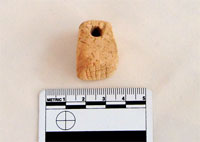 Team members in Field M finished excavating a basement room of the Iron II building being uncovered there. While clearing out the earth layer above the cobble floor, Anita found a stamp seal made of light volcanic tuff incised with hash marks on the end. This is a fine addition to the growing corpus of similar tuff seals found this season and in past ones at ‘Umayri. Use of these seals indicates a social context when literate scribes were a scarce commodity and other individuals of some importance utilized stamps with geometric patterns to indicate ownership and authority. The rest of the field was brought into phase preserving the most complete layer of courtyard paving and in the process an intrusive pit was defined and recorded. Field director Lizzie now has to keep track of six phases of paving, pitting, repaving, and wall construction. But this clarity has only been achieved through the careful work of the entire team.
Team members in Field M finished excavating a basement room of the Iron II building being uncovered there. While clearing out the earth layer above the cobble floor, Anita found a stamp seal made of light volcanic tuff incised with hash marks on the end. This is a fine addition to the growing corpus of similar tuff seals found this season and in past ones at ‘Umayri. Use of these seals indicates a social context when literate scribes were a scarce commodity and other individuals of some importance utilized stamps with geometric patterns to indicate ownership and authority. The rest of the field was brought into phase preserving the most complete layer of courtyard paving and in the process an intrusive pit was defined and recorded. Field director Lizzie now has to keep track of six phases of paving, pitting, repaving, and wall construction. But this clarity has only been achieved through the careful work of the entire team.
As we return to the field next week to take final photos and complete our drawings and plans, we are pleased with the discoveries made in each of the areas. But not all the answers are in. We are already beginning to think about where we would like to dig next season and the questions that will have to wait until next time.
Cultural Immersion, End Times, and the Hospitality Vortex
As John McDowell and Kent Bramlett have already noted, it’s at this point in the season that we begin to think about the time of the end. The pace picks up, research tasks increase in number and intensity, focus sharpens on what we have to complete before next Wednesday, camp and dig site are abuzz with people pushing to meet pressing deadlines, and there are people to meet and greet before we leave and shopping for friends, moms and dads, brothers and sisters to finish. We have also found several occasions to immerse ourselves in the local Jordanian culture in remarkably enriching ways. Some of these activities include:
Academic field school – Ken Crane of La Sierra University and David Hopkins of Wesley Theological Seminary have helped coordinate the series of lectures, learning station visits, hands-on activities, symposia and trips to nearby sites which make up the field school component of the `Umayri excavations. Students registered for credit are required to attend and most of the rest of the staff also participate. This year’s schedule:
Lectures
Tues 29 June – Archaeological Periods in Jordan and Surrounding Regions (Kent Bramlett)
Thur 1 July – Research Design of the Madaba Plains Project (Douglas Clark)
Sun 4 July – Regional Archaeological Mini-conference–Madaba
Learning Station Visits
Tues 6 July – Processing and Documentation (Suha Huffaker, Audrey Shaffer, Ruth Kent, John McDowell, Jillian Logee, Larry Murrin, Matt Vincent)
Thur 8 July – Ceramics and Lithics (Canty Wang and Nikki Oakden)
Symposia/Workshops
Tues 13 July – Amman Training College Palestinian Orphan Camp (volunteer organizers from Baqa` Refugee Camp)
Thur 15 July – Ancient Textiles (Mary Boyd)
Sun 18 July – Zizia Potters and Bedouin Family Visit
Tues 20 July – The Early Iron Age – Daily Life surrounding the Four-room House (meeting at the tell with Douglas Clark)
Thur 22 July – The Tell and Its Hinterland (meeting at Site 84 with David Hopkins)
Conversational Arabic
Monday evenings with Husam Shahroor, administrative office of Amman Training College
Closedown schedule – This weekend marks the beginning of a carefully orchestrated schedule of activities aimed at bringing our excavations to a close for the 2010 season, ensuring that our records are entirely up to date, inventories taken, our objects and artifacts registered with the Department of Antiquities and prepared for shipment to La Sierra and beyond, our equipment returned from the tell to the Amman Training College for storage, and our personal items packed up that we are taking back home or having stored. This is a team effort which takes over a week to accomplish, the commitment of all members of the team, and patience with each other.
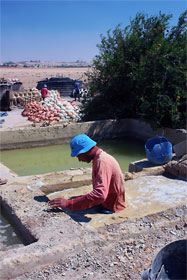 The potters of Zizia – To provide one way of understanding how ancient inhabitants of `Umayri made and used pottery, the bread and butter of “dirt” archaeology, we typically schedule a trip to see the Egyptian potters of Zizia, located about 35 kilometers from our dig camp. This year we went on Sunday 18 July. With a massive supply of the types of soil needed for ceramics production nearby, these seasonal potters from Egypt mix and process several types of clay along with sand and salt through several stages – getting the mixture of ingredients just right, levigating the small clay particles in water, straining out larger particles, drying the clay into a usable consistency, stomping the air bubbles out, forming cylinders of soft clay for use on the pottery wheels, shaping vessels of different kinds, allowing the appropriate drying to occur, placing everything into the recycled-trash-fueled kilns, firing the vessels, removing them, then preparing them for shipment and sale.
The potters of Zizia – To provide one way of understanding how ancient inhabitants of `Umayri made and used pottery, the bread and butter of “dirt” archaeology, we typically schedule a trip to see the Egyptian potters of Zizia, located about 35 kilometers from our dig camp. This year we went on Sunday 18 July. With a massive supply of the types of soil needed for ceramics production nearby, these seasonal potters from Egypt mix and process several types of clay along with sand and salt through several stages – getting the mixture of ingredients just right, levigating the small clay particles in water, straining out larger particles, drying the clay into a usable consistency, stomping the air bubbles out, forming cylinders of soft clay for use on the pottery wheels, shaping vessels of different kinds, allowing the appropriate drying to occur, placing everything into the recycled-trash-fueled kilns, firing the vessels, removing them, then preparing them for shipment and sale. 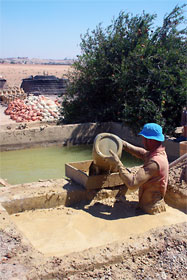
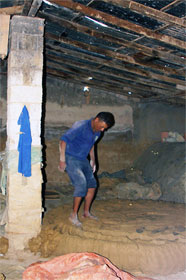
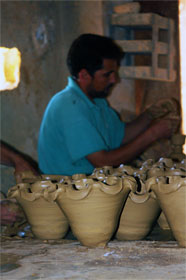
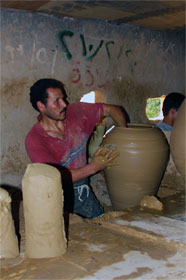
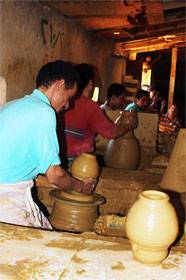
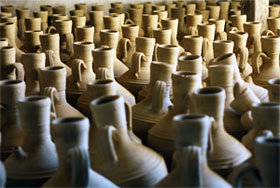
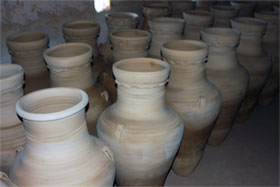
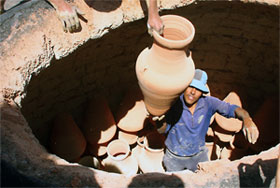

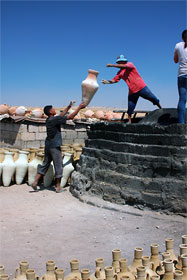
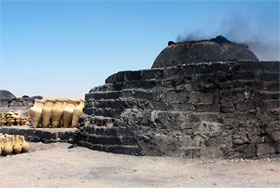
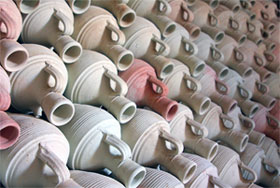
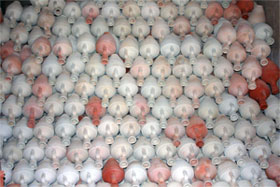
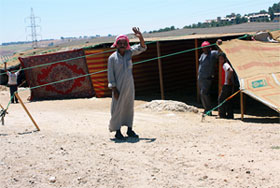 Bedouin tent hospitality – Also on Sunday, we visited a bedouin tent just across the airport highway from Tall al-`Umayri. This was a special occasion for all of us. There is nothing better calculated to immerse one into traditional Arab society (ancient and modern) than experiencing the hospitality of a Bedouin tent host and family. The photos provide a record of over an hour in the hospitality section of the tent where men and women enjoyed coffee processed from the stage of roasting and pounding to the host’s personally serving this high-octane brew calculated to create a buzz lasting several days.
Bedouin tent hospitality – Also on Sunday, we visited a bedouin tent just across the airport highway from Tall al-`Umayri. This was a special occasion for all of us. There is nothing better calculated to immerse one into traditional Arab society (ancient and modern) than experiencing the hospitality of a Bedouin tent host and family. The photos provide a record of over an hour in the hospitality section of the tent where men and women enjoyed coffee processed from the stage of roasting and pounding to the host’s personally serving this high-octane brew calculated to create a buzz lasting several days. 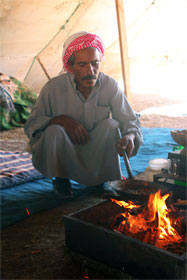 We also enjoyed bedouin sweet tea along with conversations with the host, some relatives and some of his children, translated for us by Romel Gharib. For another 15 minutes, the females in our group went into the women’s section of the tent where neither men nor photographs were allowed, in order to see the kitchen and living quarters and to sample warm goat’s milk fresh from the animal.
We also enjoyed bedouin sweet tea along with conversations with the host, some relatives and some of his children, translated for us by Romel Gharib. For another 15 minutes, the females in our group went into the women’s section of the tent where neither men nor photographs were allowed, in order to see the kitchen and living quarters and to sample warm goat’s milk fresh from the animal.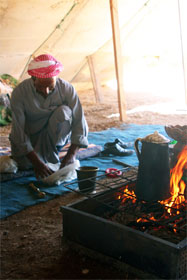

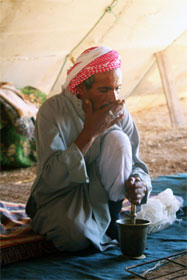
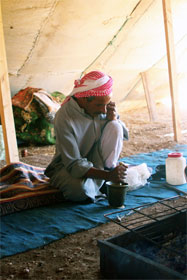
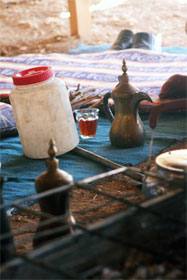
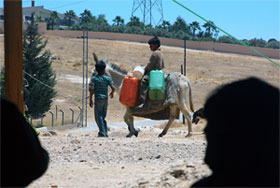
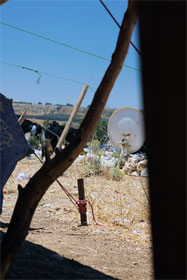
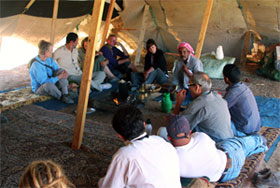
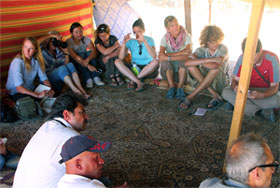
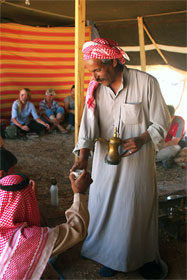
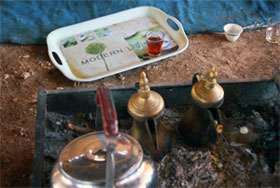
Overheard
“In Jordan there are many problems … and there are no problems. We are looking for solutions” – Rafat Hamarneh, our shipping agent.
“Three cups of coffee” – bedouin tent host noting that drinking three cups of high-octane Arab coffee with a tent host makes one a part of the family.
“Drink your coffee” – bedouin tent host explaining what a victim (even of the loss of a loved one through an accident) might choose to say to the one who inadvertently caused the accident, which releases the offender from any liability.
“Keifhal al ilah” – according to Husam Shahroor our conversational Arabic teacher, the appropriate third question opening any conversation (business or personal, in person or on the phone), which means “How is the family?” Follows “Keif halak” “How are you?” and “Humdulillah” “Thanks be to God!”
“I know why Amman is shining” – long-time La Sierra University friend and MBA graduate, Mustafa Al-Barari, president of the Audit Bureau of the Kingdom of Jordan, to several of us, celebrating our coming to Jordan.
“Because you are in the Middle East” – according to Romel Gharib, our Department of Antiquities representative, the response to the question “Why?” that the scorpion gave to the frog ferrying it across a river, having stung the frog in the middle of the stream so that both would die.